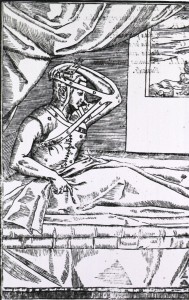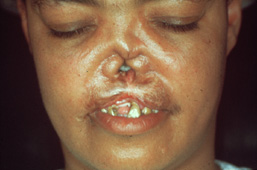THE RAVAGES OF WARFARE, PUBLIC VIOLENCE, AND DISFIGURING NEW DISEASES made the Renaissance an age of surgical innovation, and professor of secrets Leonardo Fioravanti was a witness to one of the most amazing innovations of all: Surgical reconstruction of the nose, known in medical terms as rhinoplasty . It’s a pretty amazing story in itself. Here’s what happened:
In 1549, traveling from Palermo to Naples, Fioravanti decided to stop off in a little fishing village called Tropea on the Tyrrhenian coast. Although nowadays the town is famous for its red onions and not much else, in Fioravanti’s day Tropea was the home of a family of skilled surgeons who had perfected an art of rebuilding damaged noses by means of plastic surgery, or rhinoplasty. When Fioravanti arrived, the art was being practiced with unmatched skill by two brothers who worked together in the same house. Their names were Pietro and Paolo Vianeo.
Sicilian surgeons began practicing rhinoplasty in the early fifteenth century, but its origins have been traced as far back as the sixth century, B.C.E., when it was described in the Susruta, the basic text of Hindu medicine. Branca de’ Branca, a Catania surgeon, practiced a technique similar to the Hindu method, which required cutting a flap of skin from the cheek and grafting it to the nose. His son Antonio is credited with abandoning the Hindu method and taking the reparative skin flap from the arm, thus leaving the face unscarred. The technique was further developed in the early sixteenth century by Vincenzo Vianeo of Tropea. In the manner typical of the transmission of trade secrets, Vincenzo passed the art down to his nephew Bernardino, who in turn taught it to his sons Pietro and Paolo, the brothers whom Leonardo visited. The Vianeo brothers used the method to repair noses, lips, ears, and other facial defects. They were all-around plastic surgeons and their skills were widely sought-after, partly because of the ravages of syphilis and partly because of the violent tenor of life.
One of the most shocking symptoms of advanced syphilis was the gaping hole left in the center of the face where the disease had eaten away the flesh and cartilage of the nose. The condition, known in modern medicine as saddle-nose deformity, is caused by the collapse of the nasal bridge and is relatively common among victims of congenital syphilis. With the outbreak of the syphilis epidemic in sixteenth-century Europe, the syphilitic nose became a mark of shame, a visible sign of the moral and bodily corruption that stigmatized its unfortunate victims.
Others lost their noses by more sudden means. Aristocratic violence, especially in Italy’s Spanish South, was legendary. Dueling was part of the gentleman’s code, and violent quarrels took place over even the most trivial violations of honor. In a society obsessed by maintaining la bella figura, men would constantly be on guard against insults to their honor and they would find ways to fight. Often, “duels” were little more than street brawls, but the weapons were the same and the stakes were just as high. When two hot-blooded cavaliers went at it with weapons drawn, rapiers flailed wildly in the air and the odds of receiving a blow to the head were great. The indignity of sacrificing a nose in a fight was compounded by the fact that the loser bore the mark of defeat for life, smack in the middle of the face.
Arriving in Tropea in November 1549, Fioravanti immediately sought out the Vianeo brothers. Posing as a Bolognese nobleman, he explained that he had come on behalf of a relative who had lost his nose in the battle of Serravalle, and he wanted to observe the procedure so that he could tell his relative what to expect. The brothers consented to Fioravanti’s request and when their patients were ready, they called him in to watch the procedure. “Pretending to be horrified at the sight, I turned my face away,” he writes, “but secretly I made sure I was able to see everything. I saw the whole secret from beginning to end and learned it well.”
Fioravanti was the first to describe the method employed by the Vianeo brothers. His description of the procedure is so clear that it needs little comment:
First they gave the patient a purgative. Then they took pincers and grabbed the skin in the left arm between the shoulder and the elbow and passed a large knife between the pincers and the muscle, cutting a slit in the skin. They passed a small piece of wool or linen under the skin and medicated it until the skin thickened. When it was just right, they cut the nose to fit the end of the little skin flap. Then they snipped the skin on the arm at one end and sewed it to the nose. They bound it there so artfully that it could not be moved in any way until the skin had grown onto the nose. When the skin flap was joined to the nose, they cut the other end from the arm. They skinned the lip of the mouth and sewed the flap of skin from the arm onto it, and medicated it until it was joined to the lip. Then they put a metal form on it, and fastened it there until the nose grew into it to the right proportions. It remained well formed but somewhat whiter than the face. It’s a fine operation and an excellent experience.

Illustration of the Calabrian method of rhinoplasty from Gaspare Tagliacozzi’s “De curtorum chirurgia” (1597)
One can only imagine what excruciating agony the operation must have caused. Added to the pain of the surgery was the discomfort the patient had to suffer during the prolonged healing process. The entire operation could take as long as 45 days, including 15 days during which the arm was bound to the head in a harness as the graft took hold. The risk of infection to the open wound must also have been high. Yet the success rate of the operation encouraged many to make the journey to Tropea: The Vianeo brothers had five patients waiting in line when Fioravanti visited them.
Those who endured the operation seem to have felt the discomfort and inconvenience well worth it. The humanist Camillo Porzio, who underwent the procedure to restore a nose that had been cut off in a fight with a jealous husband, admitted that he had “suffered the greatest trials” during the operation, yet he was pleased with the results, deeming his new nose “so similar to the first one that it will be difficult for those who do not know to realize that it is not the same.”
How far we’ve come since the days when plastic surgery was a tortuous ordeal! Today, plastic surgeons liken cosmetic surgery to changing a tie in the morning, simply “a desire to be in harmony with how we want to present ourselves,” as once surgeon advertises it on his website. Nips, tucks, chemical peels and Collagen injections are routine and have turned plastic surgery into television entertainment and a $12 billion a year industry.
On the other hand, some things never change. The pain and inconvenience we humans will endure to enhance our self-image seems never too great to dissuade us from shaping and reshaping our bodies.







Justinian II Rhinotmetos had a simpler solution.